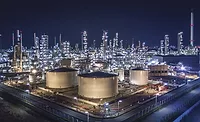High-Temperature-Resistant Coating Combats Costly Corrosion Under Insulation
New product raises the bar for industrial coatings
Sherwin-Williams has introduced a new corrosion under insulation (CUI) coating to the oil and gas industry. Heat-Flex Hi-Temp 1200 is an immersion-grade, single-component inert multipolymeric matrix coating that outperforms alternatives in aggressive multi-cycle laboratory testing. Rigorous protocols based on ASTM standards, conducted at the Sherwin-Williams labs where the first CUI coating was pioneered in 1999, documented better corrosion and abrasion resistance, and increased flexibility and harder film.
“Our testing was based on accelerated and real-world scenarios involving typical CUI mechanisms,” said Bruce Toews, Global Market Director for Oil & Gas, Sherwin-Williams Protective and Marine Coatings. “In addition to improved corrosion resistance, Heat-Flex Hi-Temp 1200 delivered enhanced durability in transit from shop to job site, and faster shop throughput. Those attributes translate into reduced total cost of ownership and extended service life for high heat applications and equipment under insulation.”
CUI is one of the costliest problems facing the hydrocarbon processing environment today. Major equipment outages, whether for periodic inspection and maintenance or due to a catastrophic failure, account for more operational disruption than any other cause. Industry standards governing the current technology and best industry practices for mitigating CUI were revised and became effective in 2011.
NACE Standard SP0198-2010, “The Control of Corrosion Under Thermal Insulation and Fireproofing Materials – A Systems Approach,” recognizes the increases that have occurred in the temperatures of hydrocarbon processing operations over the past decade – changes that demand the highest-performing products for these applications. The standard holds that immersion-grade systems are a suitable defense against infiltration by outside moisture or from the process environment itself through seams, gaps or other discontinuities in steel under insulation. Insulated steel capable of trapping water is considered to be under immersion at 210 °F or higher.
Heat-Flex Hi-Temp 1200 combines ease of application, ambient cure, surface tolerance and UV resistance in one formulation for application under calcium silicate and mineral wool insulation systems, and is recommended for use in wet/dry cyclic service at operating surface temperatures of cryogenic to 1200 °F, with application temperatures from ambient to 500 °F.
In the testing, Toews said the coated panels outperformed those of competitors, with no adhesion loss or blistering after 80 cycles of the boiling water test when applied at ambient temperatures. This test measures a coating’s performance on a steel panel subjected to thermal shock in a simulated immersion scenario. Accepted as the gold standard for accelerated testing of heat-resistant coatings, this test method measures a coating’s performance on a steel panel subjected to thermal shock in a simulated immersion scenario. Heat-Flex Hi-Temp 1200 endured a second rigorous CUI testing protocol developed by Sherwin-Williams’ R&D chemists to gauge the coating’s performance in real world scenarios involving typical CUI mechanisms as recognized in NACE SP0198-2010.
In addition, Toews said, Heat-Flex Hi-Temp 1200’s durability during transportation and erection of fabricated modules is supported by superior performance in abrasion resistance and impact testing under similar ambient temperature conditions.
Coatings formulated for immersion service are ideal for CUI because the contaminants that pass through the insulation along with the water create an aggressive operating environment. Insulation systems generally vary in their water retention, permeability and wetability characteristics; infiltration can occur due to breaks in the waterproofing, inadequate system design, incorrect installation, poor maintenance practices or a combination of the above.
Once wet, the insulation system’s weather barriers and sealants trap the water inside, keeping the insulation moist. Next to the equipment surface, the insulation forms an annular space or crevice that retains the water and other corrosive media. Sources of water include rainfall, cooling tower drift, steam discharge, wash downs and, because insulation is not vapor tight, condensation. The water may or may not contain additional contaminants; for example, rainwater may become acid rain. Chlorides and sulfates that may be native to the insulation can leach into moisture to form acids.
Learn more at http://www.sherwin-williams.com/again.
Looking for a reprint of this article?
From high-res PDFs to custom plaques, order your copy today!








